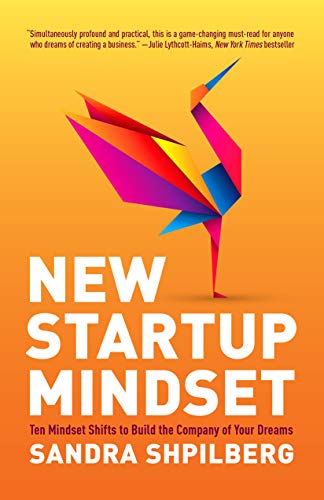Table of Contents
Sandra Shpilberg defied all stereotypes when she taught herself how to start a startup from scratch (with zero outside funding).
Shpilberg sold her company just a few years later for an incredible undisclosed sum, rocketing her to an even larger stratosphere of success. She then went on to publish a best selling book, which I had the privilege of working on as an author coach.

But even before that, Shpilberg was a force to be reckoned with. Arriving in America in her teens as an immigrant from Uruguay, Sandra’s family dealt with the harsh socio economic transition from middle class in their country of origin to poverty level in the USA.
Through impressive hard work and perseverance, Sandra got scholarship savvy and graduated from college almost debt free. She then even went on to earn an MBA from Wharton School of Business.

The best part? You can use her approach for anything you want to achieve in life.
New Startup Mindset can be applied to any audacious or creative venture you want to embark upon.
Whether you want to paint a masterpiece, start a meditation practice, write a book, create your dream job, or simply take a step and start already, this is the guide you need.
Below I’ve included some of my favorite takeaways from the book. I hope this TL;DR summary serves as a tasty amuse-bouche to whet your appetite for the main course.
Sandra has been kind enough to share her story and words of wisdom with us on the podcast, as well as the first chapter of her book New Startup Mindset: Ten Mindset Shifts to Build the Company of Your Dreams.
CLICK HERE to download the first chapter absolutely FREE and start building your next venture on your own terms now.
Or click here to buy your full copy of New Startup Mindset.
How to START a startup: A Different Approach

1. Start with a Beginner’s Mindset
What if everything you need to begin is already inside of you?
Believe it or not, being a beginner can be your superpower. Starting from square one not only gives you a fresh perspective, but frees you to create, fail, try again, detour, and finally find success without the burden of high expectations.
Do you have a voice inside your head that says you aren’t capable or don’t know enough? Shut that bully down and embrace the gift of starting from scratch.
2. Practice ‘Deep Focus’
Sandra prescribes a four step to formula as her secret to achieving a state of deep, focused work:
Create a ‘Container’, Set an Intention and Time Limit, and Practice Daily
A ‘container’ is defined as a ritual or routine that serves as a safe ‘cocoon’ for your work. This can be as simple as a daily writing habit, listening to ambient sound on headphones, turning off Wifi, or retreating to a quiet room with zero electronic distractions.
Controlling your environment is key. Whatever works best for you, find, define, and cultivate a ‘zone’ that brings out your best.
Your attention span and productivity is also not limitless. Respect your finite daily work quota. If you aren’t in the zone of high quality output, spinning your wheels is a waste of precious time and energy. For example, writer Mark Manson actually discovered the quality of his work improved when he started writing less.
Don’t buy into the multitasking myth. Set a clear intention by picking one project for your allotted work time.
Learn when to call it quits to rest, refuel, and pick it up for another day. The Pomodoro Technique can help by structuring your work time for 45 minutes, followed by a 15 minute mandatory rest.
If you’re interested in defining your ‘ONE thing’, this month’s book club pick can help you dive deeper.
Just as you would hit the gym to strengthen your body, building focus muscles requires training as well. Cultivate a ‘deep focus’ practice daily, and before you know it you’ll wake up to a venture that’s no longer starting, but has taken a life of its own!
BUILD
3. How to Start a Startup with Forward Flow
Do you feel like you have no idea what you are doing, or what to do next? Turns out, that is completely normal, even for the biggest of big shots.
Just ask Elon Musk, who describes that ‘what the hell am I doing’ feeling:
“Running a start-up is like chewing glass and staring into the abyss. After a while, you stop staring, but the glass chewing never ends”. -Elon Musk via Dan Pierson
To build something great, you don’t check off a repulsive, mile long to do list every day. But you do need constant forward motion. As a creator or founder, your one single job is to keep the momentum going, no matter what.
To cope, Sandra Shpilberg says you should ask yourself: ‘What is the next best action I can take today?’
While momentum must be forward, it doesn’t need to be fast. Some days you might take baby steps. Other days you might experience great strides. Respect the progress for what it is.
When wondering what action to take next, remember to trust yourself. Your intuition may be presenting the perfect solution – if you can learn to listen. Advice from others can be useful, but know that your inner wisdom might be wildly counter-intuitive to mainstream beliefs.
That is why ‘New Startup Mindset’ is chock full of mindfulness exercises that can help you gain a healthy distance, look at your projects from new angles, and break through to the next level.
You might be thinking: ‘That sounds great, but seriously – how do I know what to do next?’
If you’re struggling to calibrate your internal compass, let the voice of your customer be your guide. Instead of defaulting to a customer persona paper doll, get out and talk to real people, or take a walk in their shoes.
4. How to Start a Startup by Leading With Value
“There are only a few key things most VCs look at to understand and get excited about a deal: the problem you are solving, the size of the opportunity, the strength of the team, the level of competition or competitive advantage you have, your plan of attack, and current status. Summary financials, use of proceeds and milestones are also important.”
A while ago I participated in the Next:Economy conference – a forecast of what the artificial intelligence revolution would do for the future of work. Amidst a panic that robots would take all the jobs, conference founder Tim O’Reilly made the case that as long as there are problems to be solved, there would be a need for companies, jobs, and innovation.
Seek to solve a problem first, and then build a business around the solution. Fortunately, if you haven’t noticed, the world has a never ending parade of problems you can tackle.
Shpilberg offers the ‘Heart Canvas’ as a visual map of human needs you can choose to solve as a founder or creator.
Excerpt:
“The flower pot represents all the survival needs, like air, water, shelter, food and movement. Each petal represents the eight broad categories of needs: community, sustainability, autonomy, honesty, well-being, meaning, peace, empathy. Above all of these needs is the highest need for transcendence. I love this tool because it depicts the universal needs of humans by category. Most of these needs translate into potential business opportunities to serve human beings.”
Shpilberg uses the ‘Community’ petal as an example of a need filled successfully by businesses including Facebook, Slack, or Kickstarter.
You can best solve that problem if you come to know your customer as closely as you would a best friend. If you want to explore this method more deeply, I suggest digging into the book ‘Ask’.
It’s not as simple as solving just any old problem. You will go much farther if the problem you chose resonates with your greater purpose or ‘why’. I write about this more in-depth here and here
5. Feel Grateful For Your Competitors

This chapter was a true game changer for me. People love to make excuses to sit on the sidelines with the justification that the ‘idea’ exists already.
Shpilberg squelches that notion by explaining the concept of a business ‘garden’ which has enough rich soil, water, and sunlight for every kind of project or venture.
“Competition, while natural in business, is quite unnatural in mindfulness, which warns us about comparing ourselves to others. After you peeked at your competitors, ensure to bring all of your attention back to your startup. It thrives on your ability to focus.”
This chapter offers practical exercises and even a meditation to help you find your ‘segment’ or ‘niche’ space that will give you enough room to plant the seed of your idea and watch it flourish and grow.
Speaking of growth:
6. Hire a Willingness to Grow
Sandra’s first hire was an unlikely candidate: a mother who had been out of the workforce for a while. But Sharon turned out to be one of her most loyal and valuable allies.
When selecting your team, keep an open mind. Someone with a passion for your mission and a willingness to grow can be far more valuable than great ‘on paper’ credentials.
Sandra also provides pearls of wisdom on how to hire for your own weaknesses. Resist the inclination to hire your clone, and instead seek someone with opposite strengths that balance your own.
7. Let Closed Doors Show You The Way

Don’t take setbacks personally.
Every mountain you seek to climb will be full of obstacles. These bumps on the ride shouldn’t be used as an excuse to quit.
However, you may need to read the tea leaves and ask if your obstacle is worth persevering through, or signaling a redirect (or a ‘pivot’ as the startup world calls it.)
In your venture, you will encounter two types of hurdles:
1. An obstacle
The first is difficult but not impossible to surmount. This type of roadblock will make you stronger or can even give you a new super power.
2. A closed door
In comparison, a ‘closed door’ is an obstacle so big, attempting to surmount it weakens you.
A closed door is still valuable, because it is meant to show you a different way.
Making peace with both and learning to tell the difference between the two will ensure you reach the most successful outcome long term.
8. Honor Your Vessel for Creation
“Try to f*ck with your body, and your body will f*ck with you”
Burnout. Many successful people are no stranger to burnout, including Shpilberg, which is probably why she writes about it so well.
Whether you want to build a company, write a memoir, or end world hunger, your best chance at success will only come if you are functioning at a fully optimal state.
There is a reason why successful people tend to exercise every morning. The exercise ritual is creating their success, and not the other way around.
Some of this advice might sound obvious, but that doesn’t make it less critical. Food, hydration, sleep, and exercise: you need ample amounts of all four to succeed.
Love, friendship, and human connection is also a potent weapon against burnout. Make sure to surround yourself with positive people who offer unconditional acceptance.
It’s also equally important you starve any toxic or jealous relationships out of your life. If you’re really serious about building something important, there is no time for drama.
In case of emergency:
If you feel defeat, don’t quit: retreat!
At least for now. Whether it’s going on a vacation, or simply taking a ten minute meditation break daily, allocating space to rest and rejuvenate will ensure you live to fight another day.
EXIT
9. Allow a Transcendent Exit to Find You
If you are looking to sell a business for a big pay day, New Startup Mindset is an absolute goldmine of information. This is where Sandra’s MBA and heavy-hitting credentials in accounting really shine.
Not only does Shpilberg give a play-by-play of the exact steps you should take to sell your business, she also includes how you can properly prepare from Day 1 to ensure the smoothest possible transition.
She even includes visualization techniques to help you endure the roller coaster ride of finding the perfect acquirer and selling your business.
Her trusty ‘Due Diligence’ checklist will empower you to outsource yourself as a founder, find the perfect offer to accept, and finally bid your venture farewell as it sets sail for its next successful horizon.
The profound principles in this part of the playbook will no doubt arm you with the mindset you need to create the happily-ever-after ending you deserve for you and your business.
10. Trust the Universal Safety Net
Taking a leap to start something new can feel terrifying. Sandra’s theory is that if you do take that risk, you’ll be surprised at how quickly fate will meet you more than halfway.
Only a drastic show of faith will do, and the first move is on you.
In the book, Sandra outlines several potential business catastrophes that she fortuitously dodged thanks to invoking courage, honesty, and clear intentions.
I can relate because I spent years paralyzed with inaction. This book was the revelation that finally forced me to take my foot off the brake pedal. And the results were as surprising and spectacular as Sandra predicts.
At the risk of sounding ‘woo woo’, even the most hardened cynic would be at a loss to explain the serendipity that comes to your rescue when you attempt big things.
A lot of feeble words have been used to describe this powerful phenomenon over human history: kismet, luck, fate, magic, God, manifestation.
Call it what you will. It does exist, and it will come through for you if you dare to place a bet on yourself.
And with that I leave you with the question:
“What would you do if you knew you could not fail?”
After inhaling the toxic startup fumes of Silicon Valley startup culture for far too long myself, I can say this book is the road map I needed to finally stop doubting and start doing.
After coaching Sandra through the writing of New Startup Mindset, I used it as my own guide to build several businesses from scratch in the years since.
Are you wondering how to start a startup with no money from scratch, or just want to accomplish a big goal?
No matter where you are in your journey, New Startup Mindset is jam packed with value from cover to cover, even including gripping personal anecdotes from Sandra’s own journey, ten guided meditations to inspire and focus you, and a resource list of recommended reading, retreats, incubators, and accelerators that can help you start (or keep going) on your own path to success.
Ready to dive in?
Download the first chapter of New Startup Mindset absolutely free HERE.
For more of Sandra’s work, you can check our her website, or connect with her on LinkedIn, Instagram, or Twitter








